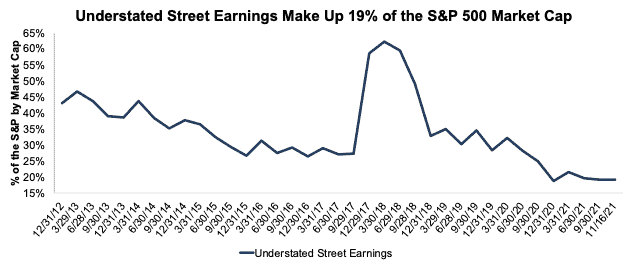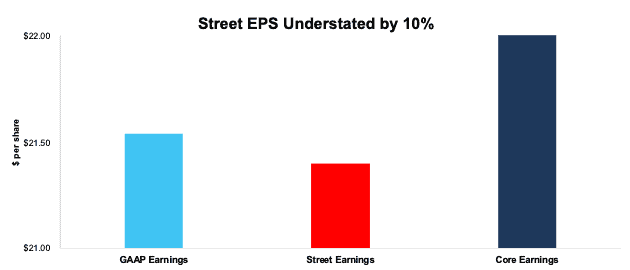While Street Earnings[1] overstate profits for the majority of S&P 500 companies, as shown in S&P 500 Companies That Overstated EPS by Over 75% in 3Q21, there are also many S&P 500 companies whose Street Earnings understate their true profits.
This report shows:
- the prevalence and magnitude of understated Street Earnings in the S&P 500
- five S&P 500 companies with understated Street estimates likely to beat 4Q21 earnings
- how Core Earnings[2] and our Earnings Distortion factor provide a new source of alpha.
Get our report on the S&P 500 companies more likely to miss 4Q21 Street EPS estimates here.
Street Understates EPS for 136 S&P 500 Companies – Least Since 2012
Over the trailing-twelve-months (TTM), the 136 companies with understated Street Earnings made up 19% of the market cap of the S&P 500, which is the lowest percent since 2012 (earliest data available). See Figure 1.
Figure 1: Understated Street Earnings as % of Market Cap: 2012 through 11/16/21
Sources: New Constructs, LLC and company filings.
When Street Earnings understate Core Earnings[3], they do so by an average of -19% per company, per Figure 2. The understatement was more than 10% of Street Earnings for 8% of companies.
Figure 2: Street Earnings Understated by -19% on Average Through 3Q21[4]
Sources: New Constructs, LLC and company filings.
Five S&P 500 Companies Likely to Beat Calendar 4Q21 Earnings
Figure 3 shows five S&P 500 companies likely to beat calendar 4Q21 earnings based on understated Street EPS estimates. Below we detail the hidden and reported unusual items that have created Street Distortion, and understated Street Earnings, over the TTM for Charter Communications (CHTR). Contact us for the same details on the other companies.
Figure 3: Five S&P 500 Companies Likely to Beat 4Q21 EPS Estimates
Sources: New Constructs, LLC, company filings, and Zacks
*Assumes Street Distortion as a percent of Core EPS equals the same percent in 4Q21 as TTM ended 3Q21
Charter Communications: The Street Understates Earnings for 4Q21 by $0.45/share
The Street’s 4Q21 EPS estimate of $6.94 for Charter is understated by $0.70/share due, at least in part, to large losses on extinguishment of debt and “special charges” in historical EPS. Our Core EPS estimate is $7.64, which makes Charter one of the companies most likely to beat Wall Street analysts’ expectations in its calendar 4Q21 earnings report.
Unusual expenses, which we detail below, materially reduced Charter’s 3Q21 TTM Street and GAAP Earnings and make profits look worse than Core EPS. When we adjust for all unusual items, we find that Charter’s 3Q21 TTM Core EPS are $23.57/share, which is better than the 3Q21 TTM Street EPS of $21.40/share and 3Q21 TTM GAAP EPS of $21.54/share.
Figure 4: Comparing Charter’s Core, Street, and GAAP Earnings: TTM as of 3Q21
Sources: New Constructs, LLC, company filings
Below, we detail the differences between Core Earnings and GAAP Earnings so readers can audit our research. We would be happy to reconcile our Core Earnings with Street Earnings but cannot because we do not have the details on how analysts calculate their Street Earnings.
Figure 5 details the differences between Charter’s Core Earnings and GAAP Earnings.
Figure 5: Charter Communication’s GAAP Earnings to Core Earnings Reconciliation: TTM as of 3Q21
Sources: New Constructs, LLC and company filings.
More details:
Total Earnings Distortion of -$2.03/share is comprised of the following:
Reported Unusual Expenses, Net = -$2.46/per share, which equals -$491 million and is comprised of:
- -$282 million in special charges in the TTM period based on
- $7 million benefit in 3Q21
- $6 million benefit in 2Q21
- -$255 million charge in 1Q21
- -$40 million charge in 4Q20
- -$273 million in other financing expenses in the TTM period based on
- -$69 million loss on extinguishment of debt in 3Q21
- -$64 million loss on financial instruments in 3Q21
- -$46 million loss on extinguishment of debt in 2Q21
- -$91 million loss on financial instruments in 2Q21
- -$29 million loss on extinguishment of debt in 1Q21
- $48 million gain on financial instruments in 1Q21
- -$22 million loss on extinguishment of debt in 4Q20
- -$100 million loss in the TTM based on a -$55 million loss on foreign currency remeasurement of Sterling Notes to U.S. dollars reported in the 2020 10-K.
- -$42 million loss on disposal of assets in the TTM period based on
- $2 million gain in 3Q21
- $3 million gain in 2Q21
- -$47 million loss in 1Q21
- -$9 million expense in the TTM based on -$31 million in “other expense” reported in the 2020 10-K.
- $270 million gain in the TTM based on a $40 million gain on the change in fair value of cross currency derivative instruments in the 2020 10-K.
- $93 million contra adjustment for recurring pension costs. These recurring expenses are reported in non-recurring line items, so we add them back and exclude them from Earnings Distortion.
- $33 million in reported other non-operating income in the TTM period based on
- -$15 million in periodic pension costs in 3Q21
- -$9 million loss on equity investments in 3Q21
- $173 million in other pension benefits in 2Q21
- -$168 million loss on equity investments in 2Q21
- $18 million in other pension benefits in 1Q21
- $15 million gain on equity investments in 1Q21
- $19 million in other pension benefits in 4Q20
- $5 million gain in the TTM based on $32 million gain on sale of assets reported in the 2020 10-K.
Hidden Unusual Gains, Net = $0.20/per share, which equals $41 million and is comprised of
- $110 million in gains to offset impairments reported in prior 10-Qs but no longer disclosed separately in the 10-K.
- -$69 million in the TTM period based on -$277 million in estimated customer credits due to COVID-19 in the 2020 10-K.
Tax Distortion = $0.23/per share, which equals $45 million
- We remove the tax impact of unusual items on reported taxes when we calculate Core Earnings. It is important that taxes get adjusted so they are appropriate for adjusted pre-tax earnings.
Given the similarities between Street Earnings for Charter Communications and GAAP Earnings, our research shows both Street and GAAP earnings fail to capture significant unusual items in Charter’s financial statements.
How to Make Money with Core Earnings & Earnings Distortion
As demonstrated above, Core Earnings do a better job of excluding unusual gains and losses and provide a more reliable earnings measure. All Core Earnings adjustments are 100% transparent; so users can audit and trust the research.
To enable you to easily monetize our new Earnings Distortion factor we present multiple trading strategies that drive alpha. Learn more below.
- ExtractAlpha presents a long/short market-neutral strategy that generates 9.3% annualized return net of Fama-French 5 factors, momentum, short-term reversal, and 12 sectors. More details here.
- CloudQuant presents two strategies to monetize the alpha in Earnings Distortion:
- the long-only portfolio outperformed the S&P 500 by an average of 4% per annum over 10 years
- the dollar-neutral long-short portfolio returned 60% over 10 years with a Sharpe Ratio of ~1 over the last five years. More details here.
- AltHub presents three strategies to monetize the alpha in Earnings Distortion:
- Earnings Distortion S&P 500 Smart Beta Portfolio: 10-yr annualized return of 13.9% vs 12.1% for the S&P 500 with a Sharpe Ratio of 0.97.
- Earnings Distortion ML Model S&P 500 Smart Beta Portfolio: 3-yr annualized return of 18.2% vs 13.7% for the S&P 500 with a Sharpe Ratio of 0.82.
- Truth Stocks (Companies without Earnings Distortion) Portfolios:
- S&P 500 Universe: 10-yr annualized return of 16.8% vs 12.8% for the S&P 500 with a Sharpe Ratio of 0.7.
- Russell 3000 Universe: 9.5-yr annualized return of 28.4% vs 12.6% for the S&P 500 with a Sharpe Ratio of 1.
- More details here.
This article originally published on January 10, 2022.
Disclosure: David Trainer, Kyle Guske II, and Matt Shuler receive no compensation to write about any specific stock, style, or theme.
Follow us on Twitter, Facebook, LinkedIn, and StockTwits for real-time alerts on all our research.
[1] Street Earnings refer to Zacks Earnings, which are adjusted to remove non-recurring items using standardized sell-side assumptions.
[2] Only Core Earnings enable investors to overcome the flaws in legacy fundamental data and research, as proven in Core Earnings: New Data & Evidence, written by professors at Harvard Business School (HBS) & MIT Sloan for The Journal of Financial Economics.
[3] Our Core Earnings research is based on the latest audited financial data, which is the calendar 3Q21 10-Q in most cases
[4] Average understated % is calculated as Street Distortion, which is the difference between Street Earnings and Core Earnings.





